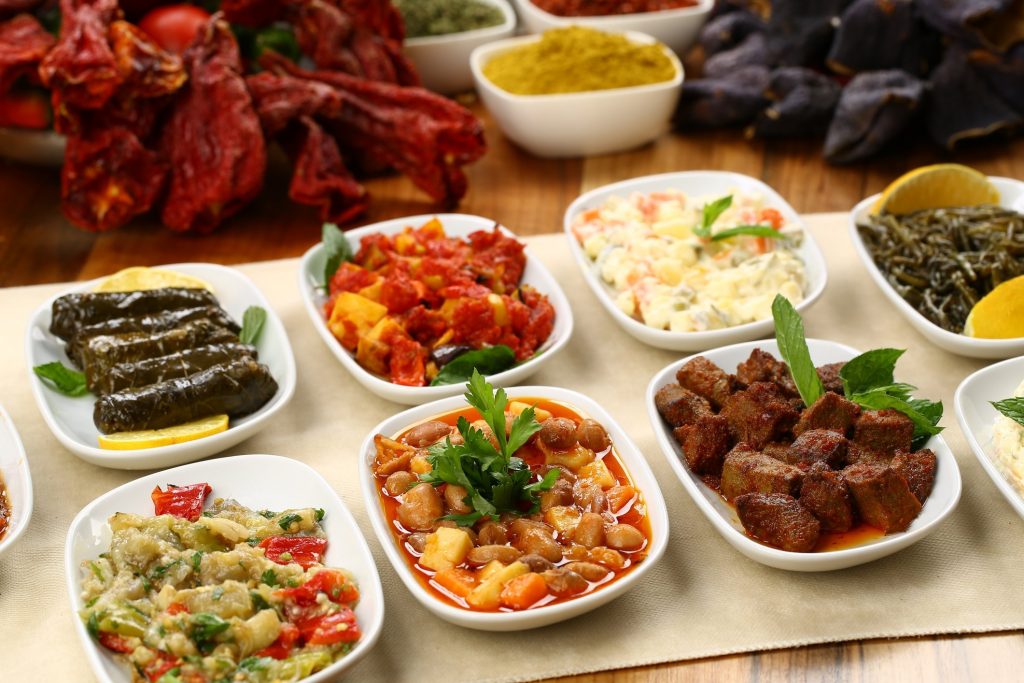Cuisine and food in North Cyprus
With its distinctive and varied flavors originating from centuries of traditional cooking, cuisine is frequently at the center of a nation’s culture. The indigenous Turkish Cypriot food is an expression of the warmth of the people, especially in North Cyprus.
In towns like Kyrenia and Famagusta, restaurants are a major draw. You’ll discover a wide variety of eateries competing for your business while offering both international and regional Turkish cuisine from North Cyprus. These foster relationships between visitors and locals in a kind and welcoming environment.
The fresh ingredients and flavorful dishes that characterize Mediterranean cuisine generally describe Cypriot cuisine. The Meze, which is frequently served as a beginning to whet guests’ appetites but may also go with main courses, is one of the most well-liked dishes.
The cuisine of North Cyprus nowadays is influenced by a wide range of nations, including Turkey, Greece, Lebanon, France, Italy, and Syria.
Meze

The centerpiece of traditional Cypriot cuisine, is a mouthwatering selection of warm and cold appetizers made up of skewered meats, grilled or marinated seafood, and a profusion of fresh vegetables and salads. With so many options, there’s a strong chance that you’ll decide to make the starters your entire meal.
Lahmacun

Lahmacun is a flavorful dish made of fresh tomatoes and minced lamb that is spread over warm flatbread and flavored with herbs and spices from the Mediterranean region. You only need to add a squeeze of lemon and roll it up to create the ideal “on-the-go” snack. The majority of establishments in North Cyprus serve this tasty delicacy.
Firin Makarna

This pasta-based dish, which is the most beautiful imitation of an Italian lasagne, is layered with tender meat, onions, and parsley and topped with a decadent homemade halloumi cheese sauce. It will surely sate any appetite.
Dolma

Dolma is a seasoned dish made of mixed meat and vegetables, including onions, peppers, tomatoes, and rice, that is wrapped in rolled vine leaves. You can make a vegetarian “yalanci dolma” by leaving out the meat.
Şeftali Kebab

No Cypriot would dream of having a barbecue without Şeftali. Either skewered as part of a mixed kebab or served alone in a Cypriot pide with a fresh salad, eftali is a sort of skinless sausage made from pork or lamb blended with onions and spices.
Kleftiko

A staple dish, kleftiko is a full leg of lamb that is slowly cooked with a mixture of white wine, lemons, and cinnamon. It is recommended to serve this melt-in-your-mouth meal with potato wedges so that they can soak up the rich, flavorful stock that is created during cooking.
Pirohu

A Cypriot dish called pirohu is packed with ricotta cheese and resembles ravioli. It’s a preferred dish to prepare at home and is served in the majority of genuine Cypriot eateries. Ricotta cheese is always added to the pirohu pastry before it is cut into shapes and boiled. Hellim or mint can be grated on top or consumed with Cypriot yoghurt as a garnish.
Bidda Badadez

A Cypriot flatbread called bidda badadez has potatoes within that are crunchy and golden. Flour, water, and salt are used to make the flatbread, which is then cooked over a wooden fire. When the potatoes are golden and crispy, they are wrapped in the flatbread after being fried in oil on the stove. For an even more delicious snack, lettuce or halloumi may occasionally be put within the wrap.
Borek

In North Cyprus, baking is a very social activity, and the ladies of the hamlet particularly like creating borek, a traditional Cypriot pastry. There are many different varieties of borek, and cheese and mince is one of the most well-liked.
A pastry dough is produced and rolled out to a very thin consistency to prepare the borek. After being filled with various seasonings, the borek is cooked till golden. Yum!
Ekmek Kaymakli Kadayifi

The ideal way to have this syrup-soaked sponge pudding is with a generous dollop of kaymak, a form of clotted cream. This made-in-heaven pairing results in a delectable dessert that can be enjoyed throughout the year.
Turkish Coffee

Turkish coffee, which the Ottoman Turks introduced to the West in the fifteenth century, is a staple of daily life in Northern Cyprus. Today, it is highly well-liked all around the world. Turkish coffee is made by cooking sugar and powdered coffee into a fine powder, which results in a thick cream on top.
Small coffee cups are used to serve Turkish coffee, which comes in three flavors: sekerli, which is sweet, orta, which is unsweetened, and sade, which is medium sweet. Before it is served, you will be questioned about how you like it.




Join The Discussion